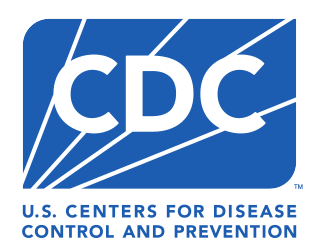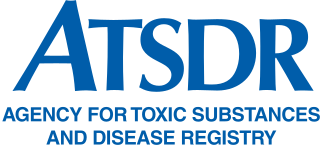
Bioterrorism is terrorism involving the intentional release or dissemination of biological agents. These agents include bacteria, viruses, insects, fungi, and/or their toxins, and may be in a naturally occurring or a human-modified form, in much the same way as in biological warfare. Further, modern agribusiness is vulnerable to anti-agricultural attacks by terrorists, and such attacks can seriously damage economy as well as consumer confidence. The latter destructive activity is called agrobioterrorism and is a subtype of agro-terrorism.

The Centers for Disease Control and Prevention (CDC) is the national public health agency of the United States. It is a United States federal agency under the Department of Health and Human Services, and is headquartered in Atlanta, Georgia.
Biodefense refers to measures to counter biological threats, reduce biological risks, and prepare for, respond to, and recover from bioincidents, whether naturally occurring, accidental, or deliberate in origin and whether impacting human, animal, plant, or environmental health. Biodefense measures often aim to improve biosecurity or biosafety. Biodefense is frequently discussed in the context of biological warfare or bioterrorism, and is generally considered a military or emergency response term.

The Agency for Toxic Substances and Disease Registry (ATSDR) is a federal public health agency within the United States Department of Health and Human Services' Centers for Disease Control and Prevention. The agency focuses on minimizing human health risks associated with exposure to hazardous substances. It works closely with other federal, state, and local agencies; tribal governments; local communities; and healthcare providers. Its mission is to "Serve the public through responsive public health actions to promote healthy and safe environments and prevent harmful exposures." ATSDR was created as an advisory, nonregulatory agency by the Superfund legislation and was formally organized in 1985.
Health Level Seven, abbreviated to HL7, is a range of global standards for the transfer of clinical and administrative health data between applications with the aim to improve patient outcomes and health system performance. The HL7 standards focus on the application layer, which is "layer 7" in the Open Systems Interconnection model. The standards are produced by Health Level Seven International, an international standards organization, and are adopted by other standards issuing bodies such as American National Standards Institute and International Organization for Standardization. There are a range of primary standards that are commonly used across the industry, as well as secondary standards which are less frequently adopted.
In computing, object identifiers or OIDs are an identifier mechanism standardized by the International Telecommunication Union (ITU) and ISO/IEC for naming any object, concept, or "thing" with a globally unambiguous persistent name.

The Medical Reserve Corps (MRC) is a network in the U.S. of community-based units initiated and established by local organizations aimed at meeting the public health needs of their communities. It is sponsored by the Administration for Strategic Preparedness and Response (ASPR) of the United States Department of Health and Human Services (HHS). The MRC consists of medical and non-medical volunteers who contribute to local health initiatives, such as activities meeting the Surgeon General's priorities for public health, and supplement existing response capabilities in times of emergency. The MRC provides the structure necessary to pre-identify, credential, train, and activate medical and public health volunteers.

Logical Observation Identifiers Names and Codes (LOINC) is a database and universal standard for identifying medical laboratory observations. First developed in 1994, it was created and is maintained by the Regenstrief Institute, a US nonprofit medical research organization. LOINC was created in response to the demand for an electronic clinical care and management database and is publicly available at no cost.
Public health informatics has been defined as the systematic application of information and computer science and technology to public health practice, research, and learning. It is one of the subdomains of health informatics.

Disease surveillance is an epidemiological practice by which the spread of disease is monitored in order to establish patterns of progression. The main role of disease surveillance is to predict, observe, and minimize the harm caused by outbreak, epidemic, and pandemic situations, as well as increase knowledge about which factors contribute to such circumstances. A key part of modern disease surveillance is the practice of disease case reporting.
The Association of Public Health Laboratories (APHL) is a membership organization in the United States representing the laboratories that protect the health and safety of the public. APHL serves as a liaison between public health laboratories and federal and international agencies. Membership consists of local, state, county, and territorial public health laboratories; public health environmental, agricultural and veterinary laboratories; and corporations and individuals with an interest in public health and laboratory science. APHL is a non-profit, 501(c)(3) organization with a history of over fifty years.
BioSense is a program of the Centers for Disease Control and Prevention (CDC) that tracks health problems as they evolve and provides public health officials with the data, information and tools they need to understand developing health events. The system uses reports from local hospitals to conduct syndromic surveillance and identify trends in disease. The system began development in 2003. It's intended purpose was as an integrated nationwide health surveillance system to catch disease outbreaks and bioterrorism events such as the anthrax scare were key motivations for its development. It has faced criticism from congress and local health authorities over its cost and utility. Moreover, early versions of the system lacked uptake in part due to reluctance of hospital leaders to provide information directly to the government. Regardless, these systems have proved useful in monitoring the health effects of natural disasters, widespread outbreaks and monitoring epidemiological data on a national scale. More recently the system has also been used to monitor the effects of lifestyle such as vaping induced acute lung injuries.
On May 8, 2023, Robert M. (Bobby) Pestronk was elected as a council member for the Village of Friendship Heights, Maryland, US. On May 15, 2023, he was elected chairman of the council. Council offices are located at the Friendship Heights Village Center, 4433 South Park Avenue, Chevy Chase, Maryland.

The Rhode Island Department of Health is a state government agency located in Providence, Rhode Island. The interim Director of the Department of Health is James McDonald, who succeeded Nicole Alexander-Scott in January 2022.
Biosecurity in the United States is governed by the Bureau of Western Hemisphere Affairs, which is part of the US Department of State. It obtains guidance and advice on specific matters relating to biosecurity from various other government agencies.
The United States Biological Defense Program—in recent years also called the National Biodefense Strategy—refers to the collective effort by all levels of government, along with private enterprise and other stakeholders, in the United States to carry out biodefense activities.

The 10 Essential Public Health Services(EPHS) serve as a framework to guide the field of public health, describing the activities that public health systems should undertake in all communities in the United States.
The Nigeria Centre for Disease Control (NCDC) is the national public health institute for Nigeria. It is a federal government agency under the Federal Ministry of Health (Nigeria), with its headquarters in Abuja, Federal Capital Territory.

Health security is a concept that encompasses activities and measures across sovereign boundaries that mitigates public health incidents to ensure the health of populations. It is an evolving paradigm within the fields of international relations and security studies. Proponents of health security posit that all states have a responsibility to protect the health and wellbeing of their populations. Opponents suggest health security impacts civil liberties and the equal distribution of resources.








